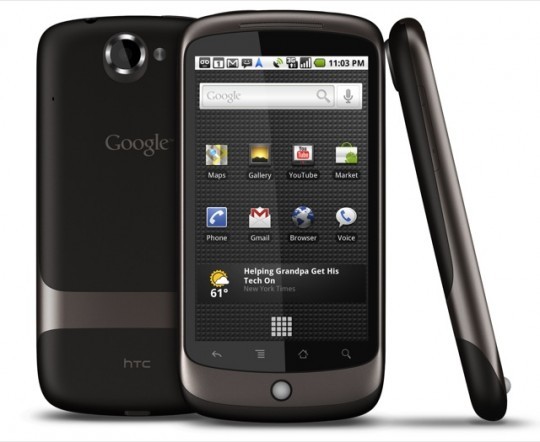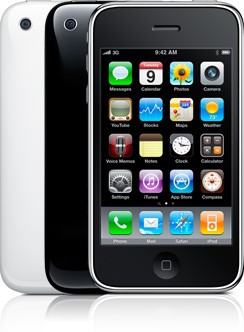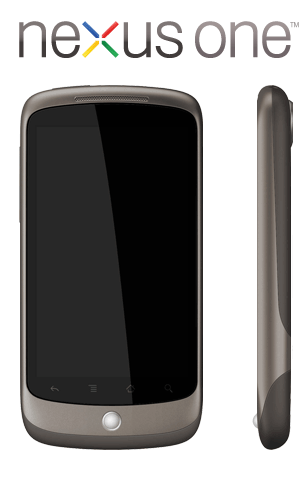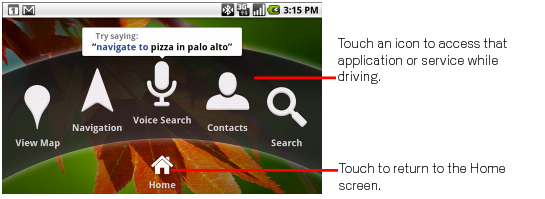The Google Nexus One is the first Google branded (HTC manufactured) phone. This unlocked “iPhone Killer” is currently available for purchase through Google for $529, or through T-Mobile for $179 with new 2-year contracts. It is expected to be available for the Verizon network (CDMA networks) in Spring of 2010. The Nexus One operates on the GSM standard and will work with any SIM card provider, but will not deliver 3G speeds on the AT&T network due to their 850 MHz 3G band used. UPDATE: Google has announced a version of the Nexus One will be released that will work on AT&T’s 3G network, and Rogers Wireless in Canada. People will still have to purchase the unlocked version for use on these networks.
| Size and Weight | Display |
|
Height: 119mm Weight: 130 grams w/battery |
3.7-inch (diagonal) widescreen WVGA AMOLED 800 x 480 pixels 100,000:1 typical contrast ratio 16.7 million colors 1ms typical response rate |
| Processor | Operating System |
| Qualcomm QSD 8250 1 GHz |
Android Mobile Technology Platform 2.1 (Eclair)
|
| Capacity | Location |
| 512MB Flash
512MB RAM 4GB Micro SD Card (Expandable to 32 GB) |
Assisted global positioning system Cell tower and Wi-Fi positioning Digital compass Accelerometer
|
| Camera/Flash/Video | Cellular and Wireless |
|
5 megapixels Autofocus from 6cm to infinity 2X digital zoom LED flash User can include location of photos from phone’s Video captured at 720×480 pixels at 20 frames |
UMTS Band 1/4/8 (2100/AWS/900) HSDPA 7.2Mbps HSUPA 2Mbps GSM/EDGE (850, 900, 1800, 1900 MHz) Wi-Fi (802.11b/g) Bluetooth 2.1 + EDR A2DP stereo Bluetooth |
| Power and Battery | Usage |
| Removable 1400 mAH battery
Charges at 480mA from USB, at 980mA |
Talk time Up to 10 hours on 2G Up to 7 hours on 3G Standby time Up to 290 hours on 2G Up to 250 hours on 3G Internet use Up to 5 hours on 3G Up to 6.5 hours on Wi-Fi Video playback Up to 7 hours Audio playback Up to 20 hours |
| Other | |
| SIM Card slot, Micro SD (4GB expansion up to 32GB), trackball, multi-color LED notification, 3.5mm headphone jack (standard), light and proximity sensors to save battery |
The Nexus One was released on January 5th, 2010, and is the newly crowned “iPhone Killer”. The name supposedly comes from the novel Do Androids Dream of Electric Sheep (later made into the movie Blade Runner) featuring a series of robots called Nexus 6 models (Google is currently being sued by the author’s estate). Other theories about the name state it comes from the Rob Zombie song “More Human Than Human”, or from the sci-fi movie Star Trek Generations in which the Nexus is a ribbon of energy that makes people believe their wishes come true. It operates on a 1GHz Snapdragon processor, with a beautiful 800×480 AMOLE D (Active-matrix organic light-emitting diode) touchscreen which has about 250 dots per inch (compare to Apple’s upcoming iPad with 1,024×768 pixels on a 9.7 inch screen at about 132 dots per inch) on the latest Android OS 2.1 (Eclair). The processor is 60% faster than the ones used in the iPhone 3GS, Palm Pre, and BlackBerry Bold 9700. While it loses a physical keyboard, the svelte figure no thicker than a pencil, seems to make it all worth it. The new champion also touts something many of the Android phones have missed: multi-touch capabilities, an ability it gained in an upgrade after its release for its Browser, Gallery and Maps applications. It comes pre-installed with Google Voice, Google Chrome browser, Google Navigation, and common tools such as a calendar, calculator, and more.
D (Active-matrix organic light-emitting diode) touchscreen which has about 250 dots per inch (compare to Apple’s upcoming iPad with 1,024×768 pixels on a 9.7 inch screen at about 132 dots per inch) on the latest Android OS 2.1 (Eclair). The processor is 60% faster than the ones used in the iPhone 3GS, Palm Pre, and BlackBerry Bold 9700. While it loses a physical keyboard, the svelte figure no thicker than a pencil, seems to make it all worth it. The new champion also touts something many of the Android phones have missed: multi-touch capabilities, an ability it gained in an upgrade after its release for its Browser, Gallery and Maps applications. It comes pre-installed with Google Voice, Google Chrome browser, Google Navigation, and common tools such as a calendar, calculator, and more.
 Android 2.1 has many scintillating features that may not have been available with previous versions. It offers integration with more than just one Gmail account, and also interfaces with Yahoo, Hotmail, Apple’s MobileMe, and virtually any other e-mail provider. The Nexus One syncs to the Google cloud, versus the Apple iPhone’s need to sync to iTunes.
Android 2.1 has many scintillating features that may not have been available with previous versions. It offers integration with more than just one Gmail account, and also interfaces with Yahoo, Hotmail, Apple’s MobileMe, and virtually any other e-mail provider. The Nexus One syncs to the Google cloud, versus the Apple iPhone’s need to sync to iTunes.
It also incorporates features from Motoblur used on the Motorola Cliq, which integrates Facebook contacts, information, pictures, and their updates into their contact profile. If the contacts already exist in your contact list and they are not exactly the same, they will be duplicated. The multiple contact listings can be synced together in a manual and ultimately slow, process.
With or without the use of the car charging dock, the Nexus One turns into a navigation device utilizing the Google Navigation app and providing turn-by-turn directions. The Google Navigation app is only available on Android OS 2.0 and higher and includes easy search with no need for an address, voice search, traffic information, and street view pictures as you approach your destination. Traffic information is compiled by data sources and Google’s “crowdsourcing” in which information on location and speed is harvested anonymously from phones using Google Maps and GPS. Using the Car Home app makes the icons larger and easier to see and use. The physical car dock has yet to be released, but is expected “soon”. UPDATE: The car dock is now available! It can be purchased separately or bundled with a Nexus One and costs $55. Besides easy access to navigation apps, it also acts as a handsfree phone device, and the dock charges the phone while it’s seated. It ships with an adhesive disc that allows it to be mounted on non-smooth surfaces. The charger fits a 12v utility socket, and the holder can rotates for flexible orientation. It also comes with built-in speakers and volume controls to “enhance the in-car music and media experience”.
Some other cool features include “living” wallpapers which move and shift in the background (something you can disable to improve battery life), improved weather widgets, five home screens (which is standard on the Motorola Cliq already, three screens came with the Droid), voice typing for all text fields (handy when the phone doesn’t have a keyboard) a 3D photo gallery from Cooliris, and more.
Another accessory currently available for the Nexus One is the Desktop Dock, which runs $45.00. It can be used with the wall adapter, or plugged into a computer and automatically launches the Clock app. It also includes a 3.5mm RCA jack to connect the dock to a stereo to listen to the phone’s music. The Clock app features include:
- Check the local time and weather
- Set and clear alarms
- Watch a slideshow of your photos
- Play music
- Dim your phone’s display for nighttime use
The Nexus One, like any other Google phone, can access the Android Market directly from the phone. The Android Market officially hit 20,000 apps in December 2009 and is believed to have around 30,000 apps currently, many of them free. This number is expected to grow continually with its Open Source nature. The Apple iTunes Store hit 133,979 apps on January 15, 2010. Unfortunately, all of the apps downloaded from the Android market are stored on internal memory instead of the micro SD card.
Adobe has been developing a Flash player for mobile phones, and the 10.1 is available on the Nexus One. This is something that Adobe is not developing for the iPhone currently. Having the Flash player will enable Nexus One users to view many websites they were unable to before on their phone.
Nexus One vs. iPhone 3Gs
 |
 |
| Google Nexus One | Apple iPhone 3Gs | |
| Size |
Height: 119mm (4.7 inch) Weight: 130 grams w/battery |
Height: 115.5 mm (4.5 inch) Width: 62.1 mm (2.4 inch) Depth: 12.3 mm (.48 inch) Weight: 4.8 ounces |
| Processor | Qualcomm QSD 8250 1 GHz (Snapdragon) | 600MHz CPU |
| Capacity | 512MB Flash
512MB RAM 4GB Micro SD Card (Expandable to 32 GB) |
256MB RAM 16GB or 32GB Flash Memory Micro SD Card Slot (expandable to 32 GB) |
| Display |
3.7-inch (diagonal) widescreen WVGA AMOLED 800 x 480 pixels 100,000:1 typical contrast ratio 16.7 million colors |
3.5 inch multi-touch, 480×320 163 ppi
|
| Camera |
5 megapixels Autofocus 2X digital zoom LED flash Video captured at 720×480 pixels at 20 frames per second or higher, depending on lighting conditions |
3 megapixels Auto-focus No flash Video captured at 30 frames per second video at 640×480 |
| Apps | Android Market (30,000 apps) | iTunes Store (134,000 apps) |
| Price |
$529 unlocked |
$199 (16GB) w/ 2 yr contract $299 (32GB) w/ 2 yr contract |
| Network | T-mobile, AT&T, works with any GSM network Sprint, Verizon & Vodafone coming soon |
AT&T Verizon in the future(?) |
The Nexus One sets new standards for Android phones and smartphones alike and Google’s distribution model challenges the stronghold that wireless carriers have on phones. Though there may be many tweaks, fixes and upgrades in the future, the Nexus One is a look into what cellphones have in store for us in this rapidly changing wireless world.

$69.99
after instant discount with a new T-Mobile account

$19.99
after instant discount with a new Verizon Wireless account

$99.99
after instant discount with a new T-Mobile account


